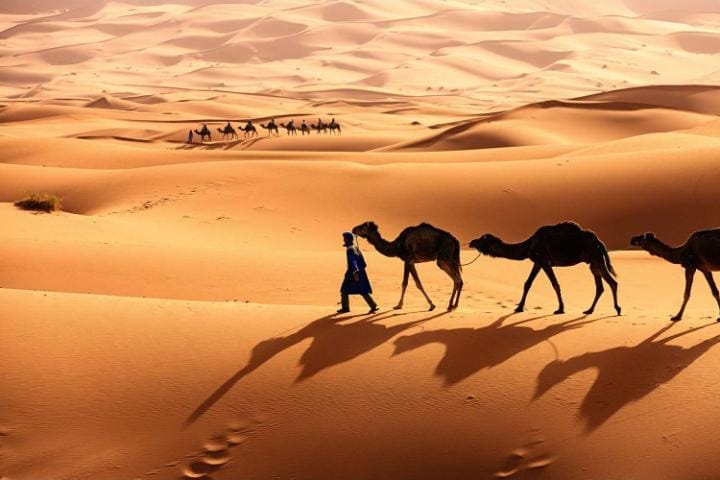The Sahara Desert, the largest hot desert globally, spans North Africa, covering approximately 9.2 million square kilometers. Its name, derived from Arabic, means “desert.” This vast expanse is bordered by the Atlantic Ocean, the Mediterranean Sea, the Red Sea, and the Sahel region.
The Sahara’s terrain includes sand seas, rocky plateaus, and oasis depressions, hosting a diverse array of wildlife like the fennec fox, dromedary camel, and Saharan cheetah.
Nomadic communities, like the Tuareg and Berbers, have traversed its shifting sands for centuries, embodying resilience and adaptability.
The Sahara Desert is not controlled by a single country; instead, it spans across several nations. Algeria, Chad, Egypt, Libya, Mali, Mauritania, Morocco, Niger, and Tunisia all have territories within the Sahara.
READ ALSO: Top 10 African Countries With High Hunger Rate
The desert’s borders are marked by the Mediterranean Sea to the north, the Atlantic Ocean to the west, the Red Sea to the east, and the Sahel region to the south. This vast territory is home to numerous countries, each with its unique culture and history.
The Sahara Desert is home to a variety of fascinating animals. The fennec fox, known for its oversized ears, is well adapted to the harsh desert environment. The dromedary camel, with its distinctive hump, is a symbol of the desert and has been used by nomadic communities for centuries.
The Saharan cheetah, a critically endangered subspecies, roams the desert’s dunes. Other animals found in the Sahara include the dorcas gazelle, the addax antelope, and the scorpion-tailed lizard.
One of the most striking features of the Sahara Desert is its unique landforms. The Richat Structure, a massive circular formation, is a geological wonder. The Tibesti range, a deeply dissected mountain range, stands out against the desert’s flat expanse.
The Sahara is also home to numerous oases, which provide vital sources of water and shelter for the desert’s inhabitants. The oases are often surrounded by lush vegetation, creating a stark contrast to the arid desert landscape.
The Sahara Desert has a rich history, with ancient trade routes and cultural traditions. The trans-Saharan trade route, which connected West Africa to the Mediterranean, was a vital artery of commerce.
The Sahara was also home to numerous ancient civilizations, including the Tuareg and the Berbers. The desert’s history is marked by the struggles of its inhabitants to survive in the harsh environment, as well as the cultural exchange and trade that occurred across its vast expanse.
READ ALSO: 10 African Countries, Their Currencies, and Their Exchange Rate in Dollars
The Sahara Desert is also home to several unique adaptations that have evolved to cope with its extreme conditions. The Tuareg people, for example, have developed a unique culture that is deeply connected to the desert.
Their traditional clothing, which includes long robes and turbans, helps protect them from the intense desert sun. The Berbers, another indigenous group, have developed a sophisticated system of agriculture that relies on the desert’s limited rainfall.
In conclusion, the Sahara Desert is a fascinating and complex environment that is home to a diverse array of wildlife, unique landforms, and a rich cultural heritage. Its vast expanse spans across several countries, each with its own unique traditions and adaptations.
The Sahara is a testament to the resilience and adaptability of its inhabitants, who have thrived in one of the most challenging environments on Earth.

